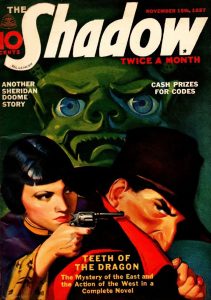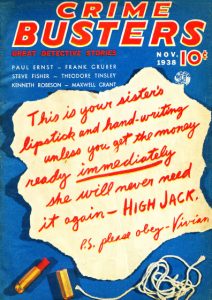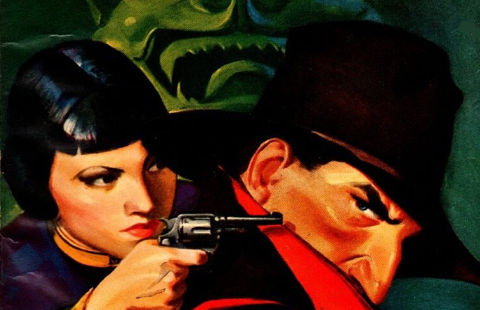 Maxwell Grant was a pen name used by the authors of The Shadow pulp magazine stories. Street & Smith, the publishers of THE SHADOW MAGAZINE, asked Walter B. Gibson, the writer they originally hired to chronicle the Shadow’s adventures, to create a pen name so that numerous authors could be used to write the stories without confusing the readers. Gibson, who was also a nonfiction writer, adopted the pen name Maxwell Grant, taking the name from two magic dealers he knew, Maxwell Holden and U. F. Grant.
Maxwell Grant was a pen name used by the authors of The Shadow pulp magazine stories. Street & Smith, the publishers of THE SHADOW MAGAZINE, asked Walter B. Gibson, the writer they originally hired to chronicle the Shadow’s adventures, to create a pen name so that numerous authors could be used to write the stories without confusing the readers. Gibson, who was also a nonfiction writer, adopted the pen name Maxwell Grant, taking the name from two magic dealers he knew, Maxwell Holden and U. F. Grant.
Four authors besides Gibson have used the Maxwell Grant pseudonym over the years: Theodore Tinsley, who wrote 27 Shadow stories between 1936 and 1943; Lester Dent, who wrote one story, “The Golden Vulture,” in 1938; Bruce Elliott, who wrote fifteen Shadow stories between 1946 and 1948; and Dennis Lynds, who wrote nine Shadow paperback novels between 1964 and 1967.
Although most hardboiled pulp fiction in the pulps featured male protagonists, some very dangerous dames also found their way into the rough paper magazines. These hardboiled ladies helped to pave the way for such modern day gumshoes as Sue Grafton‘s Kinsey Millhone, Marcia Muller‘s Sharon McCone, and Sara Paretsky‘s V. I. Warshawski. As part of our celebration of the “hardboiled dicks, dangerous dames, and a few psychos,” of the pulps, please join PulpFest 2017 on Thursday evening, July 27, at 10:30 PM as Anthony Tollin explores “The Dangerous Dames of Maxwell Grant: Myra Reldon, Margo Lane, and Carrie Cashin.”
Although Margo Lane is, by and large, the best known of these three characters, she is probably the least dangerous of Grant’s dames. Writing in DEADLY EXCITEMENTS, the late Robert Sampson remarked, “. . . she was a feather-headed nitwit, a flighty pest who lacked any sense of personal danger. . . . The Shadow treated her rather humorously, as if she were a kitten full of catnip. She caused more trouble than she was worth.”
The character was originally created for the Mutual radio broadcasts networks and debuted in 1937. A friend and companion to Lamont Cranston, Margo Lane spies for his alter ego, The Shadow. She would later make her first print appearance in the The Shadow newspaper strips. In 1941, Walter B. Gibson included her in her first pulp novel, “The Thunder King.”
Myra Reldon was the first female agent to work for The Shadow. Born in Shanghai, she had spent many years in Asia learning the languages and the customs of the Chinese. This led her to become an undercover agent for the U. S. Department of Justice, where she disguised herself as “Ming Dwan,” and investigated Chinese matters. The Shadow came in contact with her while working on a case in San Francisco’s Chinatown. He was impressed with her talents and brought her into his organization. Her first appearance was in the 1937 story, “The Teeth of the Dragon.”
 Although he used his real name for the Carrie Cashin stories, Theodore Tinsley was the writer who most often — after Walter Gibson — hid behind the Maxwell Grant house name. Attractive as sin, hard-boiled as hell, and one of the very first of the hardboiled lady dicks of the pulps, Carrie Cashin appeared in over three dozen action-packed, fast-paced stories, starting in the November 1937 issue of Street & Smith’s CRIME BUSTERS. This dangerous dame continued in that magazine through a name change — to MYSTERY MAGAZINE in 1939 — right up to her final appearance in November 1942, one of the last issues of the pulp.
Although he used his real name for the Carrie Cashin stories, Theodore Tinsley was the writer who most often — after Walter Gibson — hid behind the Maxwell Grant house name. Attractive as sin, hard-boiled as hell, and one of the very first of the hardboiled lady dicks of the pulps, Carrie Cashin appeared in over three dozen action-packed, fast-paced stories, starting in the November 1937 issue of Street & Smith’s CRIME BUSTERS. This dangerous dame continued in that magazine through a name change — to MYSTERY MAGAZINE in 1939 — right up to her final appearance in November 1942, one of the last issues of the pulp.
Anthony Tollin, publisher, writer, and researcher, is best known for his reprints of Doc Savage, The Shadow, The Spider, and other pulp heroes, issued through the Sanctum Books imprint. These books serve as a source of entertainment and knowledge for veteran pulp fans as well as a major gateway for new people to enter the pulp-collecting hobby. Additionally, Tony was the co-author — with Walter Gibson — of THE SHADOW SCRAPBOOK, and helped to put together and introduce numerous recorded collections of pulp-related radio programs during his association with Radio Spirits. He was also involved with several comic book interpretations of the great pulp heroes and worked as a colorist for many years, primarily for DC Comics. In 2011, Anthony received the Munsey Award for his many contributions to the pulp community.
(Myra Reldon, one of the dangerous dames created by the authors who hid behind the pseudonym of Maxwell Grant, first appeared in the November 15, 1937 issue of THE SHADOW, published by Street & Smith and featuring front cover art by George Rozen.
Although he used his own name for the Carrie Cashin stories, Theodore Tinsley also used the Grant pseudonym, writing 27 of The Shadow’s pulp adventures. His most dangerous dame, Ms. Cashin, was featured in 39 issues of CRIME BUSTERS and MYSTERY MAGAZINE. From time to time, she garnered top cover billing on the magazine — including the November 1938 issue, featuring work by an unknown artist — that also ran the adventures of Lester Dent’s Click Rush, Walter B. Gibson’s Norgil the Magician, Frank Gruber’s Jim Strong, Norvell Page’s The Death Angel, and others.)







